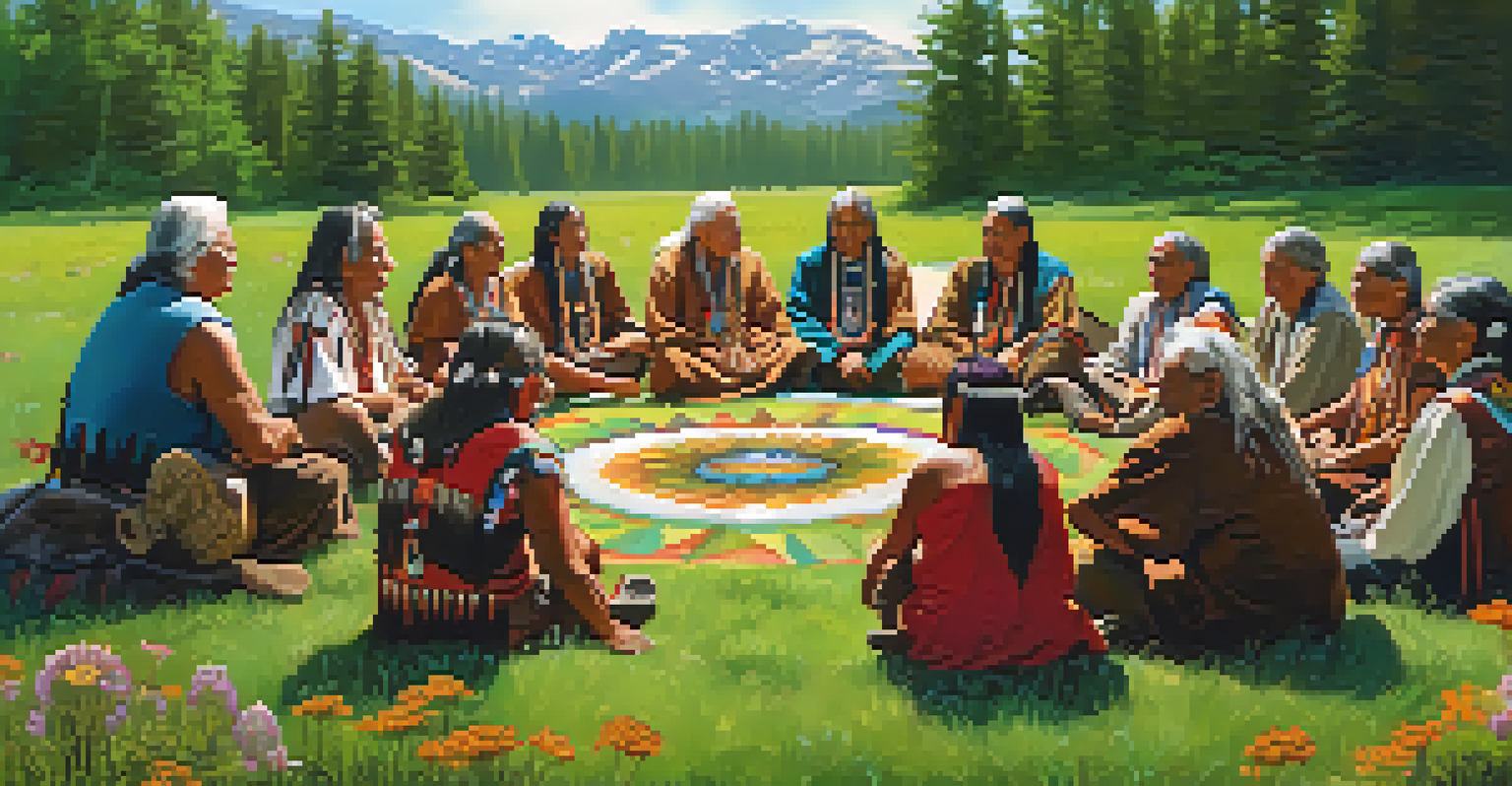Peyote Songs: The Heartbeat of Ritual Language

Understanding the Essence of Peyote Songs
Peyote songs are deeply rooted in Native American culture, serving as a vital component of spiritual ceremonies. These songs are often sung during peyote rituals, which are held to connect with the divine and seek guidance. The melodies and lyrics, passed down through generations, encapsulate the beliefs, values, and history of the people.
Music is the shorthand of emotion.
Each song carries a unique meaning, often reflecting themes of healing, connection, and the natural world. For many, these songs are not just music; they are a form of communication with the spiritual realm. They embody a sacred language that transcends words, resonating with the heartbeat of nature and the universe.
In essence, peyote songs play a crucial role in the cultural identity of Native American tribes, reinforcing their traditions and fostering community. Understanding these songs means appreciating the rich tapestry of stories and experiences they represent.
The Role of Music in Rituals
Music has always played an essential role in rituals across various cultures, and peyote songs are no exception. In the context of peyote ceremonies, music serves as a conduit for spiritual connection, helping participants move into a meditative state. The rhythm and repetition of the songs create a sense of unity among participants, enhancing the collective experience.

During these ceremonies, the songs often accompany the consumption of peyote, a cactus known for its psychoactive properties. As the participants engage with the peyote, the music deepens their experience, guiding them through visions and insights. This interplay of music and spirituality can lead to profound moments of realization and healing.
Peyote Songs: Spiritual Communication
Peyote songs serve as a sacred language that connects participants with the spiritual realm during rituals.
Moreover, the communal aspect of singing these songs fosters a strong bond among participants, reinforcing a shared sense of purpose. It’s a beautiful reminder of how music can unify and elevate the human experience, especially in sacred contexts.
The Lyrics: A Language of Spirituality
The lyrics of peyote songs are often rich with symbolism and metaphor, reflecting the complexities of existence and the spiritual journey. Many songs narrate stories from creation myths or recount personal experiences of healing and transformation. This lyrical depth allows for multiple interpretations, inviting listeners to reflect on their own lives and struggles.
Songs are the pulse of a culture, capturing its essence in melody and lyric.
Peyote songs often include elements of nature, emphasizing the interconnectedness of all living things. For instance, references to animals, plants, and celestial bodies serve as reminders of the sacredness of the natural world. This language of spirituality nurtures a sense of respect and reverence for the environment, which is central to many Native American philosophies.
By engaging with these songs, participants not only honor their heritage but also cultivate a deeper understanding of their place within the universe. The lyrics become a means of exploring one’s identity and spirituality, enriching the ritual experience.
The Importance of Oral Tradition
Peyote songs are primarily transmitted through oral tradition, which is a cornerstone of many Indigenous cultures. This method of sharing knowledge ensures that the songs evolve while preserving their original essence. Elders play a crucial role in this process, passing down the songs and their meanings to younger generations, fostering a sense of continuity.
Through oral tradition, the stories embedded in these songs remain vibrant and relevant. Each generation has the opportunity to interpret and adapt the songs, infusing them with contemporary experiences while honoring the past. This dynamic process keeps the culture alive and thriving.
Oral Tradition Preserves Culture
The transmission of peyote songs through oral tradition enables the preservation and evolution of Native American culture.
Moreover, oral tradition fosters a strong community bond as individuals gather to learn and share these songs. It creates a space for storytelling, connection, and cultural pride, reinforcing the significance of peyote songs in the communal identity.
Celebrating the Peyote Ceremony
The peyote ceremony is a sacred event that typically lasts all night, centered around the consumption of peyote and the singing of songs. This gathering is not just about the drug; it’s a holistic experience that includes prayer, meditation, and communal support. Participants often seek healing, guidance, or clarity during these ceremonies, making the atmosphere one of reverence and introspection.
The ceremony is often led by a designated leader, known as a 'roadman,' who guides the participants through the process. The roadman’s role includes choosing the appropriate peyote songs to sing, which are vital for creating the right spiritual ambiance. Their expertise ensures that the ceremony flows smoothly, allowing participants to fully immerse themselves in the experience.
Through the act of singing together, participants feel a profound sense of belonging and collective healing. The peyote ceremony, with its songs at the heart, is a powerful testament to the strength of community and the healing power of music.
Modern Interpretations and Adaptations
In recent years, there has been a growing interest in peyote songs beyond traditional contexts, with some artists incorporating these melodies into contemporary music. This fusion of styles not only broadens the audience but also ensures that the essence of these songs continues to resonate with new generations. It’s a fascinating evolution that reflects the adaptability of culture.
While some may view these adaptations as a dilution of tradition, many Native American musicians argue that it’s a way to keep their heritage alive. By blending traditional peyote songs with modern genres, they create a bridge between the past and the present, inviting wider appreciation for their culture. This dialogue across generations and styles enriches the cultural landscape.
Music Unites in Peyote Ceremonies
The act of singing together during peyote ceremonies fosters a strong sense of community and collective healing.
However, it’s essential for artists to approach these adaptations with respect and understanding of the original meanings. Authenticity remains crucial in honoring the traditions while exploring new creative avenues.
Conclusion: The Lasting Legacy of Peyote Songs
Peyote songs are more than just melodies; they are a profound expression of spirituality, culture, and community. They encapsulate the experiences and beliefs of Native American tribes, serving as a vital link to their heritage. As we explore these songs, we gain insights into the depth of their significance and the beauty of their tradition.
The ongoing practice of peyote singing within ceremonies highlights the resilience of Indigenous cultures in the face of modern challenges. Through oral tradition and communal participation, these songs continue to thrive, adapting while retaining their core messages. This dynamic legacy is a testament to the power of music as a means of cultural preservation.

Ultimately, peyote songs remind us of the importance of connection—both to each other and to the natural world. As we honor these traditions, we acknowledge the rich tapestry of human experience and the universal search for meaning.